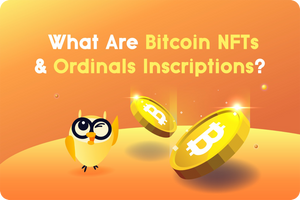In previous blog articles, we’ve covered the basics around cryptocurrency, a broad view of NFTs, and taken a closer look at popular cryptocurrencies such as Bitcoin and Ethereum.
👀 In this article, we’ll offer a brief guide looking at the latest way to create NFTs on Bitcoin – Ordinals inscriptions. We’ll cover the history of Bitcoin NFTs and define what Ordinals are, how they work and provide some examples.
❓ WHAT ARE ORDINALS INSCRIPTIONS?
🚀On 20th January, 2023, software engineer and developer Casey Rodarmor launched Ordinals on the Bitcoin mainnet. Ordinal NFTs feature a fundamentally different architecture to other Bitcoin NFTs.
👉Ordinals are means of creating Bitcoin NFTs by attaching data such as images, videos, and more to an individual satoshi on the base Bitcoin blockchain.
Rather than existing on a separate layer, ordinal NFTs use an arbitrary but logical ordering system called ordinal theory to give each individual Bitcoin satoshi a unique number.
👉A “satoshi”, or “sat”, is equivalent to 1/100,000,000 of a single Bitcoin, the smallest possible denomination of Bitcoin.
BRC-20 is the experimental fungible token standard using ordinal inscriptions on Bitcoin.
Bitcoin Ordinals and BRC-20 tokens have only been made possible by the 2017 scaling proposal called Segregated Witness (SegWit), and the more recent implementation of the Taproot upgrade, which brought smart contract📄 functionality to Bitcoin.
⚙️ HOW DO ORDINAL NFTs WORK?
The terms “ordinals” and “inscriptions” are used to refer to this new type of Bitcoin NFT but their meanings differ.
- Ordinals are a system for ordering sats in a way that creates the “non-fungible” property necessary to create NFTs
- Inscriptions are the contents of the ordinal NFT itself – the image, text, video, or any other arbitrary data that a user would consider synonymous with an NFT.
Ordinal NFTs are made up of two primary components:
TokenID – provides each NFT with a unique barcode via a system of numbering for each individual satoshi, making it unique and non-fungible.
Metadata – the arbitrary data (art, in-game assets, profile pictures, financial assets etc.) attached to a specific satoshi “inscribed” within that specific part of a Bitcoin transaction, making it an inscription.
🤷♂️ HOW ARE ORDINALS DIFFERENT FROM OTHER NFTs?
NFTs on other blockchains, such as Ethereum with its ERC-721 standard, have a metadata file that provides information about the NFT by pointing to off-chain data on the Interplanetary File System (IPFS). In contrast, Bitcoin’s Ordinal NFTs aren’t linked to a file of referenceable metadata that describes the NFT.
With Ordinals, the entire data file resides in the witness signature field of Bitcoin transactions. The entirety of these NFTs live and breathe on the blockchain, bringing an additional level of immutability.
🛍️ NOTABLE ORDINALS INSCRIPTIONS
Paying homage to CryptoPunks, Ordinal Punks is a set of 100 Bitcoin NFTs in a PFP collection minted within the first 650 inscriptions.
Beginning with Inscription #652, Taproot Wizards is an Ordinal collection of hand-drawn NFT wizards created by web3 developer Udi Wertheimer.
Other notable Ordinals inscriptions include Yuga Labs’ TwelveFold, OnChainMonkey and Degods.
🔮 ORDINALS INSCRIPTIONS: LOOKING AHEAD
A recent development will allow Ordinals to be used in a way similar to Ethereum-based NFTs via an Ordinals Collection Protocol known as BRC-721. It aims to add support for collections, introduce a post-reveal mechanism for metadata, and improve the process of creating and verifying Ordinal collections.
That being said, the current popularity and hype around Bitcoin Ordinals may be just a fad with little long-term longevity in support. They could be wrong, but many in the crypto community are beginning to feel as if the trend may not last. Bitcoin developers are witnessing record high fees and congestion. Some are even proposing introducing a “bugfix” that may prevent Ordinals operating on the Bitcoin blockchain.
Some Bitcoin traditionalists (or “purists”) also feel that Ordinals clogging up the network with extra congestion goes against how Bitcoin was purely designed – for the transaction of value (as laid out in founder Satoshi Nakamoto’s whitepaper). Others, however, feel that Ordinals are making use of the empty space often wasted in each Bitcoin block.
📈At the time of writing, Ordinals NFTs have surpassed over 7 million inscriptions. With its rising popularity and spike in traffic and adoption, it's ultimately up to the Bitcoin community to collectively decide whether or not Ordinals are here to stay.
👉 EARNING NFTs WITH BLOOM
📲.They might not be Bitcoin Ordinals but the Bloom shopper rewards app allows you to earn NFTs and other crypto (like Bitcoin, Ethereum and a range of other altcoins) with every purchase made on your Visa card💳.
🦉 All you need to do is download the Bloom app, register an account, link your Visa card and shop anywhere using your credit or debit card.
💰 With every purchase, you will earn Bloom Coins by simply using your Visa card💳. The more you use your card, the more Bloom Coins you will earn.
🎁 Bloom Coins earned can be redeemed for rewards within the app, such as NFTs or crypto.
🆓 Converting crypto on Bloom is free of charge and has no gas fees!
💎 Earn exclusive 3x Bloom Coin rewards with a Premium Membership.
The information provided on this website does not constitute investment advice, financial advice, trading advice, or any other sort of advice and you should not treat any of the website's content as such. Bloom does not recommend that any cryptocurrency or NFTs should be bought, sold, or held by you. Do conduct your own due diligence and consult your financial advisor before making any investment decisions.
